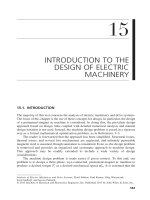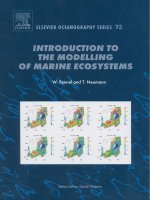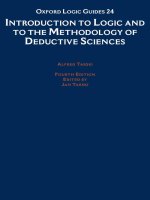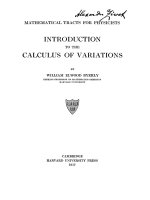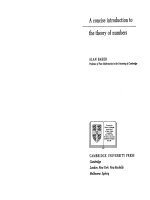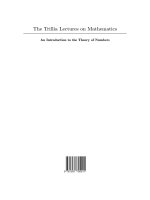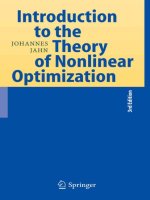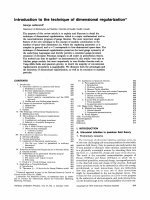Introduction to Logic and to the Methodology of Deductive Sciences
Bạn đang xem bản rút gọn của tài liệu. Xem và tải ngay bản đầy đủ của tài liệu tại đây (11.7 MB, 254 trang )
Oxford
Logic
Guides
General Editors
Dov
Gabbay
Angus
Macintyre
Dana Scott
OXFORD
LOGIC GUIDES
1.
Jane Bridge: Beginning model theory:
the
completeness theorem
and
some
consequences
2.
Michael Dummett: Elements
of
intuitionism
3. A. S.
Troelstra:
Choice sequences:
a
chapter
of
intuitionistic mathematics
4. J. L.
Bell: Boolean-valued models
and
independence
proofs
in set
theory
(1st edition)
5.
Krister Segerberg: Classicalpropositional operators:
an
exercise
in the
foundation
of
logic
6. G. C.
Smith:
The
Boole-DeMorgan correspondence 1842-1864
7.
Alec
Fisher: Formal number theory
and
computability:
a
work book
8.
Anand Pillay:
An
introduction
to
stability theory
9. H. E.
Rose: Subrecursion: functions
and
hierarchies
10.
Michael Hallett: Cantorian
set
theory
and
limitation
of
size
,
11. R.
Mansfield
and G.
Weitkamp: Recursive aspects
of
descriptive
set
theory
12. J. L.
Bell: Boolean-valued models
and
independence
proofs
in set
theory
(2nd edition)
13.
Melvin Fitting: Computability theory: semantics
and
logic programming
14. J. L.
Bell: Toposes
and
local
set
theories:
an
introduction
15.
Richard Kaye: Models
of
Peano
arithmetic
16.
Jonathan Chapman
and
Frederick Rowbottom: Realtive category theory
and
geometric morphisms:
a
logical approach
17. S.
Shapiro: Foundations without foundalionalism
18. J. P.
Cleave:
A
study
of
logics
19.
Raymond
M.
Smullyan: Gddel's incompleteness theorems
20. T. E.
Forster:
Set
theory with
a
universal
set
21. C.
McLarty: Elementary categories, elementary toposes
22.
Raymond
M.
Smullyan: Recursion theory
for
metamathematics
23.
Peter Clote
and Jan
Krajice'k:
Arithmetic,
Proof
Theory
and
Computational
Complexity
24.
Alfred
Tarski: Introduction
to
Logic
and to the
Methodology
of
Deductive
Sciences,
4th
edition edited
by Jan
Tarski
Introduction
to
Logic
and
to the
Methodology
of
the
Deductive Sciences
by
Alfred
Tarski
fourth
edition edited
by Jan
Tarski
New
York Oxford
OXFORD
UNIVERSITY PRESS
1994
The
original translation
by
Olaf
Helmer
was
thoroughly
revised
for
this
edition.
Oxford University
Press
Oxford
New
York
Toronto
Delhi
Bombay Calcutta Madras Karachi
Kuala
Lumpur Singapore Hong Kong Tokyo
Nairobi
Dar es
Salaam Cape Town
Melbourne Auckland Madrid
and
associated companies
in
Berlin
Ibadan
New
material
in
this Edition
Copyright
©
1941, 1946, 1965, 1994
by
Oxford University Press, Inc.
for
the
English Language
First American Edition, 1941
Second Edition, Revised, 1946
Third Edition, Revised, 1965
Fourth
Edition,
Revised, 1994
Published
by
Oxford University
Press,
Inc.,
200
Madison Avenue,
New
York,
New
York 10016
Oxford
is a
registered
trademark
of
Oxford University
Press
All
rights
reserved.
No
part
of
this publication
may be
reproduced,
stored
in a
retrieval
system,
or
transmitted,
in any
form
or by any
means,
electronic, mechanical, photocopying, recording,
or
otherwise,
without
the
prior
permission
of
Oxford University
Press
Library
of
Congress Cataloging-in-Publication Data
Tarski,
Alfred.
[O
logice matematycznej
i
metodzie dedukcyjnej. English]
Introduction
to
logic
and to the
methodology
of
the
deductive sciences
/ by
Alfred
Tarski.
— 4th ed. /
edited
by Jan
Tarski.
p.
cm.—(Oxford logic guides;
24)
Includes
bibliographical references
and
index
ISBNO-19-504472-X
1.
Mathematics
—
Philosophy.
2.
Arithmetic
—
Foundations.
I.
Tarski, Jan.
H.
Title.
III.
Series
QA9.T28 1993
511.3—dc20 93-6104
987654321
Printed
in the
United States
of
America
on
acid-free
paper
Contents
From Author's Prefaces
to
Previous Editions
ix
Editor's
Preface
xv
A
Short Biographical Sketch
of
Alfred
Tarski xviii
First
Part.
Elements
of
Logic. Deductive Method
I
On the Use of
Variables
1
Constants
and
variables
3
2
Expressions containing variables—sentential
and
designatory
functions
4
3
Construction
of
sentences
in
which
variables occur—universal
and
existential sentences
7
4
Universal
and
existential quantifiers;
free
and
bound variables
8
5 The
importance
of
variables
in
mathematics
12
Exercises
13
II
On the
Sentential Calculus
6
Logical constants;
the old
logic
and the new
logic
17
7
Sentential calculus;
the
negation
of a
sentence,
the
conjunc-
tion
and the
disjunction
of
sentences
18
8
Implications
or
conditional sentences; implications
in the
material meaning
21
9
The use of
implications
in
mathematics
26
10
Equivalence
of
sentences
29
11 The
formulation
of
definitions
and its
rules
30
12
Laws
of
sentential calculus
32
13 The
symbolism
of
sentential calculus; compound sentential
functions
and
truth
tables
34
14
An
application
of
laws
of
sentential calculus
in
inference
39
15
Rules
of
inference,
complete
proofs
42
Exercises
44
III
On the
Theory
of
Identity
16
Logical concepts outside
sentential
calculus;
the
concept
of
identity
49
17
Fundamental laws
of the
theory
of
identity
50
18
Identity
of
objects
and
identity
of
their designations;
the use
of
quotation marks
53
vi Contents
19
Equality
in
arithmetic
and in
geometry,
and its
relationship
to
logical identity
56
20
Numerical quantifiers
58
Exercises
59
IV
On the
Theory
of
Classes
21
Classes
and
their elements
63
22
Classes
and
sentential
functions
with
one
free
variable
65
23
The
universal
class
and the
null class
67
24
The
fundamental relations among
classes
69
25
Operations
on
classes
71
26
Equinumerous classes,
the
cardinal number
of a
class,
finite
and
infinite
classes; arithmetic
as a
part
of
logic
74
Exercises
76
V On the
Theory
of
Relations
27
Relations, their domains
and
counter-domains; relations
and
sentential
functions
with
two
free
variables
81
28
The
algebra
of
relations
84
29
Several kinds
of
relations
87
30
Relations
which
are
reflexive,
symmetric,
and
transitive
88
31
Ordering relations; examples
of
other relations
90
32
Many-one relations
or
functions
91
33
One-one relations
or
bijective
functions,
and
one-to-one
correspondences
96
34
Many-place relations;
functions
of
several variables
and
operations
98
35
The
importance
of
logic
for
other sciences
101
Exercises
101
VI
On the
Deductive Method
36
Fundamental constituents
of a
deductive theory—primitive
and
defined
terms, axioms
and
theorems
109
37
Models
and
interpretations
of a
deductive theory
112
38 The law of
deduction;
formal
character
of
deductive sciences
116
39
Selection
of
axioms
and
primitive terms; their independence
• 121
40
Formalization
of
definitions
and
proofs,
formalized
deductive
theories
122
41
Consistency
and
completeness
of a
deductive theory;
the
decision problem
125
42
The
widened conception
of the
methodology
of
deductive
sciences
128
Exercises
131
Contents
Second
Part.
Applications
of
Logic
and
Methodology
in
Constructing Mathematical Theories
VII
Construction
of a
Mathematical Theory:
Laws
of
Order
for
Numbers
43 The
primitive terms
of the
theory
to be
constructed;
the
axioms concerning
the
fundamental relations among numbers
145
44
The
laws
of
irreflexivity
for the
fundamental relations;
indirect proofs
147
45
Further
theorems
on the
fundamental relations
149
46
Other relations among numbers
151
Exercises
155
VIII
Construction
of a
Mathematical Theory: Laws
of
Addition
and
Subtraction
47
The
axioms concerning addition; general properties
of
operations,
the
concept
of a
group
and the
concept
of an
Abelian
group
159
48
Commutative
and
associative laws
for
larger numbers
of
summands
161
49
The
laws
of
monotonicity
for
addition
and
their converses
. . . 162
50
Closed systems
of
sentences
167
51 A few
consequences
of the
laws
of
monotonicity
168
52
The
definition
of
subtraction; inverse operations
171
53
Definitions
whose definiendum contains
the
identity sign
172
54
Theorems
on
subtraction
174
Exercises
176
IX
Methodological Considerations
on the
Constructed
Theory
55
Elimination
of
superfluous axioms
from
the
original axiom
system
181
56
Independence
of the
axioms
of the
reduced system
184
57
Elimination
of a
superfluous
primitive term
and the
subsequent simplification
of the
axiom system;
the
concept
of
an
ordered Abelian group
186
58
Further simplification
of the
axiom system; possible
transformations
of the
system
of
primitive
terms
189
59
The
problem
of
consistency
of the
constructed theory
193
60
The
problem
of
completeness
of the
constructed theory
195
Exercises
197
vii
viii
Contents
X
Extension
of the
Constructed Theory: Foundations
of
Arithmetic
of
Real Numbers
61 The first
axiom system
for the
arithmetic
of
real numbers
. . 201
62
Closer characterization
of the first
axiom system;
its
method-
ological advantages
and
didactic disadvantages
202
63 The
second axiom system
for the
arithmetic
of
real numbers
204
64
Closer characterization
of the
second axiom system;
the
concept
of a field and
that
of an
ordered
field 206
65
Equipollence
of the two
axiom systems; methodological
dis-
advantages
and
didactic advantages
of the
second system.
. . 208
Exercises
209
Index.
213
field
From
Author's Prefaces
to
Previous Editions
Prom
the
original edition (1936)
In the
opinion
of
many laymen, mathematics
is
already today
a
dead sci-
ence: after having reached
an
unusually high degree
of
development,
it has
become petrified
in
rigid perfection.
This
is an
entirely erroneous view
of
the
situation; there
are but a few
domains
of
scientific research which
are
passing
through
a
phase
of
such intensive development
at
present
as
math-
ematics. Moreover,
this
development
is
extraordinarily manifold: math-
ematics
is
expanding
its
realm
in all
possible directions,
it is
growing
in
height,
in
width,
and in
depth.
It is
growing
in
height, since,
on the
soil
of
its old
theories which look back upon hundreds
if not
thousands
of
years
of
existence,
new
problems appear again
and
again,
and
ever stronger
and
more
refined
results
are
being achieved.
It is
growing
in
width, since
its
methods permeate other branches
of
learning,
its
domain
of
investigation
embraces ever wider ranges
of
phenomena,
and new
theories continue
to
enter into
the
large circle
of
mathematical disciplines.
And finally, it is
growing
in
depth, since
its
foundations become more
and
more
firmly es-
tablished,
its
methods perfected,
and its
principles stabilized.
It has
been
my
intention
in
this
book
to
give those readers
who are in-
terested
in
contemporary mathematics,
but who are not
actively concerned
with
it, at
least
a
very general idea
of
that
third line
of
mathematical devel-
opment, i.e.
of its
growth
in
depth.
My aim has
been
to
acquaint
the
reader
with
the
most important concepts
of an
independent discipline, which
is
known
as
mathematical logic,
and
which
was
created
for the
purpose
of
making
the
foundations
of
mathematics
firmer and
more
profound;
this
discipline,
in
spite
of its
brief
existence
of
barely
a
century,
has
already
attained
a
high degree
of
perfection,
and
today
its
role
in the
totality
of
our
knowledge transcends
by far the
originally intended boundaries.
It
'In
this book, logic
is
treated primarily
as a
discipline which strengthens
the
founda-
tions
of
mathematics.
It
would
be
natural, however,
for a
reader
to ask
whether this
discipline
may
perhaps play
a
wider
role,
and
certainly
it was
natural
for the
author
to
have been concerned with such matters.
Cf.
also
the
opening paragraph
of the
pref-
ace of
1941.—The author's remarks should appear
in a
clearer perspective
when
the
reader takes note
of a
certain philosophical activity
which
was
prominent,
and
with
which
the
author
was in
close contact.
In
fact,
the first
publication
of
Introduction
to
Logic,
in
1936,
was
about
a
decade
after
several philosophers
and
philosophically-
minded
scientists
formed
the
Vienna Circle.
Its
members wrote extensively
on
various
philosophical matters
of
broad significance, such
as
problems
of
language, knowledge,
etc.;
and as
they strove
for a
maximum
of
clarity
and
precision, they employed
freely
the
concepts
of
logic (and
of the
methodology
of
mathematics)
in
their discussions.
Among
its
members were Carnap
and
Godel,
cf.
footnote
8 on p. 130 and
footnote
7
x
From Author's Prefaces
has
been
my
intention
to
show
that
the
concepts
of
logic permeate
the
whole
of
mathematics,
that
they comprehend
all
specifically mathematical
concepts
as
special cases,
and
that
logical laws
are
constantly applied—
be it
consciously
or
subconsciously—in mathematical reasonings. Finally,
I
have tried
to
present
the
basic principles employed
in the
construction
of
mathematical theories—principles which
form
the
subject
matter
of
still
another discipline,
the
methodology
of
mathematics—and
to
show
how one
sets
about using
those
principles
in
practice.
It has not
been easy
to
carry this whole plan through within
the
frame-
work
of a
relatively small book, especially without presupposing
on the
part
of the
reader
any
specialized mathematical knowledge,
or any
broader
training
in
argumentation
of an
abstract
character. Throughout
the
book
a
combination
of the
greatest
possible intelligibility with
the
necessary con-
ciseness
had to be
attempted, while taking
a
constant
care
for
avoiding
errors
or
cruder inexactitudes
from
the
scientific
standpoint.
A
language
had to be
used which deviates
as
little
as
possible
from
the
language
of ev-
eryday
life.
The
employment
of
special logical symbolism
had to be
given
up,
although
this
symbolism
is an
invaluable tool which permits
us to
com-
bine conciseness with precision, eliminates
to a
large extent
the
possibility
of
ambiguities
and
misunderstandings,
and
provides thereby
an
essential
service
in all
subtler reasonings.
The
idea
of a
systematic treatment
had
to be
abandoned
from
the
beginning.
Of the
abundance
of
questions which
present themselves, only
a few
could
be
discussed
in
detail, some could only
be
mentioned
in
passing,
while
still others
had to be
left
out
entirely, with
the
awareness
that
the
choices which were made would inevitably exhibit
a
more
or
less arbitrary character.
In
those cases
in
which contemporary
science
has not yet
taken
any
definite stand
and
offers
a
number
of
possible
and
equally correct solutions,
it was out of the
question
to
present objec-
tively
all
known views.
A
decision
in
favor
of a
definite
point
of
view
had
to be
made. When making such
a
decision,
I
have taken care
to
choose
a
method
of
solution which would
be
simple insofar
as
possible,
and
which
would
lend itself
to a
popular mode
of
presentation, rather than
one
which
would
conform
to my
personal inclinations.—I
do not
have
any
illusion,
that
I
have entirely succeeded
in
overcoming these
and
still other
difficul-
ties. [ .]
on
p.
128. Moreover,
the
interests
and the
premisses
which
were
current among
the
members
of the
Vienna
Circle
were
likewise
adopted
(to a
greater
or
smaller extent)
by
a
number
of
philosophers elsewhere,
and in
particular,
by
those
who
were
associated
with
the
Polish school;
see A
Short
Biographical
Sketch
of
Alfred
Tarski.
From
the first
American edition (1941)
xi
Prom
the first
American edition (1941)
The
present book
is a
partially
modified
and
extended edition
of my
book
On
Mathematical
Logic
and
Deductive
Method,
which appeared
first in
1936
in
Polish
and
then
in
1937
in an
exact German
translation
(under
the
title:
Einfuhrung
in die
mathematische
Logik
und in die
Methodologie
der
Math-
ematik).
In its
original
form
it was
intended
as a
popular
scientific
book;
its
aim was to
present
to the
educated layman—in
a
manner which would
combine scientific exactitude with
the
greatest
possible intelligibility—a
clear idea
of
that
powerful
trend
of
contemporary thought which
is
concen-
trated
around modern logic.
This
trend
arose
originally
from
the
somewhat
limited
task
of
stabilizing
the
foundations
of
mathematics.
In its
present
phase, however,
it has
much wider aims.
For it
[aspires
to
relate
to] the
whole
of
human knowledge.
In
particular,
one of its
goals
is to
perfect
and to
sharpen
the
deductive method, which [not only
has a
central
place
in
mathematics,
but in
addition,
in
just about] every domain
of
intellec-
tual
endeavor, serves
as an
indispensable tool
for
deriving conclusions
from
accepted assumptions.
The
response accorded
to the
Polish
and
German editions,
and
especially
some suggestions made
by
reviewers, gave rise
to the
idea
of
making
the new
edition
not
only
a
popular
scientific
book,
but
also
a
textbook upon
which
an
elementary college course
in
logic
and the
methodology
of
deductive
sciences could
be
based.
The
experiment seemed
all the
more desirable,
in
view
of a
certain lack
of
suitable elementary textbooks
in
this domain.
In
order
to
carry
out the
experiment,
it was
necessary
to
make several
changes
in the
book.
Some
very fundamental questions
and
notions
were
entirely passed over
or
only touched upon
in the
previous editions, either because
of
their more
technical character,
or in
order
to
avoid points
of a
controversial nature.
As
examples
may be
cited
such topics
as the
difference
between
the use
of
certain terms
in the
context
of
logic
and
their
use in the
language
of
everyday
life,
the
general method
of
verifying
laws
of the
sentential calculus,
the
necessity
of a
sharp distinction between words
and
their names,
the
concepts
of the
universal class
and the
null class,
the
fundamental notions
of
the
calculus [or,
of the
algebra]
of
relations,
and finally the
conception
of
methodology
as a
general science
of
sciences.
In the
present edition
all of
these topics
are
discussed (although
not all in an
equally thorough
manner), since
it
seemed
to me
that
to
avoid them would constitute
an
essential
gap in any
textbook
of
modern logic. [
]
In
contrast
to the
previous editions,
in the
present book
I
considered
it
necessary
to
familiarize
the
reader with
the
elements
of
logical symbolism.
Nevertheless,
the use of
this
symbolism
in
practice remains very restricted,
and is
limited mostly
to
exercises.
xii
Prom Author's Prefaces
In
the
previous editions,
the
principal domain
from
which examples
were
drawn
for
illustrating general
and
abstract
considerations
was
high-school
mathematics;
for it was my
opinion,
and
still
is,
that
elementary mathemat-
ics,
and
especially algebra, with
its
simple concepts
and
uniform
methods
of
proof,
is
very appropriate
for
this purpose. Nevertheless,
in the
present
edition, particularly
in the
newly added passages,
I
draw examples more
frequently
from
other domains, especially
from
everyday
life.
[
]
The
essential features
of the
book remain unchanged.
The
preface
to
the
original edition,
the
major
part
of
which [precedes
the
present
preface],
will
give
the
reader
an
idea
of the
general character
of the
book. Perhaps,
however,
it is
worthwhile
to
point
out
explicitly
at
this place what
he or
she
should
not
expect
to find in it.
First,
the
book contains
no
systematic
and
strictly deductive presenta-
tion
of
logic; such
a
presentation
obviously would
not lie
within
the frame-
work
of an
elementary textbook. Originally
it was my
intention
to
include,
in
the
present edition,
an
additional chapter entitled
Logic
as a
Deductive
Science,
which—as
an
illustration
of the
general methodological discussion
contained
in
Chapter VI—would outline
a
systematic development
of
some
elementary
parts
of
logic.
For a
number
of
reasons this intention could
not
be
realized;
but
several exercises
on
this subject
are
included
in
Chapter
VI,
[and they
should]
to
some extent compensate
for the
omission.
Secondly,
apart
from two
rather short
passages
[and
a few
related exer-
cises
in
Chapter VI],
the
book gives
no
information about
the
traditional
Aristotelian logic,
and
contains
no
material drawn
from it. But I
believe
that
the
space here devoted
to
traditional
logic corresponds well enough
to the
small role,
to
which
the
place
of
this
logic
in
modern science
has
been reduced;
and I
also believe
that
this
opinion
will
be
shared
by
most
contemporary logicians.
And,
finally, the
book
is not
concerned with
any
problems belonging
to
the
so-called
logic
and
methodology
of
empirical sciences.
I
must
say
that
I am
inclined
to
doubt whether
any
special "logic
of
empirical sciences",
as
opposed
to
logic
in
general,
or, to the
"logic
of
deductive sciences", exists
at
all (at
least
so
long
as the
word
"logic"
is
used
as in the
present book—that
is
to
say,
as the
name
of a
discipline which analyzes
the
meaning
of the
con-
cepts common
to all
sciences,
and
establishes general laws governing these
concepts).
But
this
is a
terminological rather than
a
factual problem.
At
any
rate,
the
methodology
of
empirical sciences constitutes
an
important
domain
of
scientific
research.
The
knowledge
of
logic
is of
course valuable
in
the
study
of
this methodology,
as it is in the
case
of any
other discipline.
It
must
be
admitted, however,
that
up to the
present, logical concepts
and
methods have
not
found
any
specific
or
fertile
applications
in
this domain.
And
it is
certainly possible
that
this
state
of
affairs
is not
simply
a re-
flection
of
the
present stage
of
methodological research. Perhaps
it
arises
Prom
the first
American
edition
(1941)
xiii
from the
circumstance
that,
for the
purpose
of an
adequate
methodological
treatment,
an
empirical science
may
have
to be
considered
not
simply
as
a
scientific theory—that
is, as a
system
of
asserted
statements
arranged
according
to
certain rules—,
but
rather
as a
complex, consisting partly
of
such
statements
and
partly
of
human activities.
It
should
be
added
that,
in
striking opposition
to the
high development
of the
empirical sciences
themselves,
the
methodology
of
these sciences
can
hardly
boast
of
com-
parably definitive achievements—despite
the
great
efforts
that
have been
made. [
] For
these
and
other reasons,
I see
little
rational justification
for
combining
the
discussion
of
logic
and
that
of the
methodology
of
empirical
sciences
in the
same college course.
A
few
remarks concerning
the
arrangement
of the
book
and its use as a
college
text.
The
book
is
divided into
two
parts.
The first
gives
a
general introduction
to
logic
and to the
methodology
of
deductive sciences;
the
second shows,
by
means
of a
concrete example,
the
sort
of
applications which logic
and
methodology
find in the
construction
of
mathematical theories,
and
thus
affords
an
opportunity
to
assimilate
and to
deepen
the
knowledge
which
is
acquired
in the first
part.
Each chapter
is
followed
by
appropriate exercises.
Brief
historical indications
are
contained
in
footnotes.
Passages,
and
even
whole
sections,
which
are set off by
asterisks
"*"
both
at the
beginning
and at the
end, contain more
difficult
material
or
presuppose familiarity with other
passages
containing such material; they
can be
omitted without jeopardizing
the
intelligibility
of
subsequent
parts
of
the
book.
An
analogous remark applies
to the
exercises whose numbers
are
preceded
by
asterisks.
I
feel
that
the
book contains enough material
for a
full-year
course.
Its
arrangement, however, makes
it
feasible
to use it in
half-year courses
as
well.
If
used
as a
text
in
half-year
logic courses
in a
department
of
philosophy,
I
suggest
a
thorough study
of its first
part, including
the
more
difficult
portions, with omission
of the
entire second
part.
If the
book
is
used
in
a
half-year course
in a
mathematics department—for instance,
in the
foundations
of
mathematics—,
I
suggest
the
study
of
both
parts
of the
book,
with omission
of the
more
difficult
passages.
In
any
case,
I
should
like
to
emphasize
the
importance
of
working
out
the
exercises
carefully
and
thoroughly;
for
they
not
only facilitate
the as-
similation
of the
concepts
and the
principles which
are
introduced,
but
also
touch upon many problems
for the
discussion
of
which
the
text
provides
no
opportunity.
I
shall
be
very happy
if
this book contributes
to a
wider
diffusion
of
logical knowledge. [
] For
logic,
by
perfecting
and by
sharpening
the
tools
of
thought, makes
men and
women more critical—and thus makes
xiv
Prom Author's
Prefaces
less likely
their
being misled
by all the
pseudo-reasonings
to
which
they
are
incessantly
exposed
in
various
parts
of the
world
today.
Alfred
Tarski
September
1940
The
editor should like
to
mention
those individuals
to
whom
the au-
thor
expressed
(in the
previous
American
editions) thanks
and
gratitude:
Mr.
K. J.
Arrow,
Dr. O.
Helmer, Professor
L.
Henkin,
Dr. A.
Hofstadter,
Mr.
L. K.
Krader, Professor Louise
H. Lim
(Chin),
Dr. J. C. C.
McKinsey,
Professor
E.
Nagel, Miss
Judith
Ng,
Professor
W. B.
Pitt,
Professor
W. V.
Quine,
Mr. M. G.
White,
Dr. P. P.
Wiener.
Editor's Preface
Alfred
Tarski's
Introduction
to
Logic
and to the
Methodology
of
Deductive
Sciences
has
become recognized
as a
classic.
It was first
published
in
Polish
over
50
years ago,
and was
then
the first
popular-scientific book
to be
devoted
to
modern
logic;
its
appreciation
has
grown over
the
years.
It has
been
translated
into eleven languages.
It is
still timely
and
continues
to
draw
attention.
The
English-language
text
has
been
out of
for a
number
of
years.
After
the
author's death
in
1983
a
discussion took place about publishing
a new
edition
of the
book.
Two
kinds
of
changes were then considered.
On
one
hand, some modifications
in the
existing
text
seemed desirable,
and on
the
other,
a
possible expansion
of the
book
was
envisaged.
Considerations
of
expansion
led to
plans
for a
forthcoming companion
volume.
These plans
in
turn
affected
some
aspects
of the
present book.
For
preparation
of the new
text,
we
naturally
started
with
the
latest
American
edition:
the
third,
of
1965. (Its main
text
differs
only slightly
from
the
texts
of the first two
editions.)
Our
original intention
was to
keep
the
editorial changes
to a
minimum. Nonetheless,
the
changes turned
out
to be
fairly
numerous,
and of
several kinds.
(i)
In
Chapter
V a
change
of
convention
was
made, regarding
the
passage
from
a
relation
to a
function.
A
function
is now
defined
as a
many-one
relation,
so
that
upon starting with "xRy",
we are led to the
functional
formula:
"f(x)
=
y".—This convention
follows
the
original Polish
text.
In
the
previous American editions, instead,
a
function
was
defined
as a
one-
many
relation,
and one was led to "x =
f(y)".
The
difference
is
trivial,
but it
affects
several sections
of the
chapter,
and it
required
modifying
not
only
formulas
but
also
the
discussion.
(ii)
Some
of the
exercises
in
Chapter
VI
were
intended
as an
introduction
to a
deductive development
of
logic. Their content
will
now be
utilized
in
the
companion volume,
and the
exercises were
therefore
removed.
New
exercises,
which
are of the
same general kind
but are
somewhat more ele-
mentary,
are
provided
in
their place.
(iii)
The
section
Suggested
Readings
was
removed.
An
edited version
of
this section
will
be
included
in the
companion volume.
(iv)
A new
section,
A
Short
Biographical
Sketch
of
Alfred
Tarski,
is in-
cluded.
(v)
A
number
of
editor's footnotes were
added.
They
are
marked with
daggers: "f",
T -
(vi)
Notation
was
changed
so as to
conform
to the
prevalent usage
of to-
day.
This applies especially
to the
notation
for
quantifiers
and for
classes.
xvi
Editor's
Preface
The
terminology
was
likewise largely modernized.
One
important change
was the
replacement
of
"biunique function"
by
"bijective
function". Fur-
thermore,
a few
historical
and
other remarks were
no
longer appropriate,
and
they were brought
up to
date.
(vii)
A few
excerpts were
set in
italics
for
emphasis, even though they
are not
displayed.
(viii)
There
are
approximately
25
sentences whose content
was
altered
(including
some
in
exercises
and in the
author's
preface
of
1941).
(ix)
Extensive stylistic changes were made throughout
the
book.
(x)
Three asterisks
are now
used
to
signal
a
change
of
topic within
a
section.
The
gaps which were employed
for
this purpose
in the
previous
editions
had
several drawbacks.
(xi)
A few
simple adjustments were made
in
section titles. These adjust-
ments relate
to the
modernization
of
terminology
and to
stylistic changes
(points (vi)
and
(ix)).
(xii)
Finally,
the
index
was
revised
so as to
take into account
the
various
changes,
and was
modified
somewhat otherwise.
We
should like
to
comment
on
points
(viii)
and
(ix).
It is
always
diffi-
cult
to
eliminate completely
the
rough
spots
in a
book,
and in
this case
there were particular adverse factors.
The
English text
was
produced
as a
"translation
of a
translation", with some additions.
This
work
was
carried
out
under
the
pressure
of
time,
and
under otherwise
difficult
circumstances.
Finally,
the
subsequent editions
were
photographic reprints,
in
which
one
could
accommodate only minimal changes
of the
main
text.
For an
example
of a
change
of
content
we
refer
to
Section
19,
where
we
modified
the
author's
critical remarks concerning
the
traditional usage
of
the
term
"equality"
in
geometry.
With regard
to
matters
of
style,
the
previous
text
clearly lost some qual-
ity by the
double-translation
effect.
As
example,
the
word "thing" appeared
throughout
the
book, with
reference
to
numbers, classes, etc.
The
original
Polish edition
had
"przedmiot", meaning
"object",
this
was
translated into
German
as
"Ding",
and
then into English
as
"thing". This
last
word
has
now
been replaced throughout
by
"object".
While
going over
the
previous English
text
we
checked numerous passages
against
the
original Polish,
and in a
number
of
cases
we
attempted
to
provide
an
improved
translation.
For
the
editorial revision
of the
main
text,
footnotes,
and
exercises,
the
following
rules
of
procedure were
adopted
and
strictly
followed:
Aside
from
the
revisions described
in (i) and
(ii), there
are no
changes other
than
those
involving
individual sentences.
No
sentences were deleted,
no
sentences
were
rearranged,
and no
sentences were added except
as
editor's footnotes.
Moreover,
the
structure
of
each paragraph
was
left
intact.
(Two exceptions
were
made:
In
Section
57 the
division into
paragraphs
was
changed,
so as
to
conform
to the
original edition,
and in
Section
58 the
former
statement
Editor's
Preface xvii
(III)
now has the
place (V).
In
addition,
the
foregoing
rules were modified
slightly
for the
prefaces; stylistic changes were made there without com-
ment,
as
elsewhere,
but
other alterations
are
indicated.)
We
hoped
that
by
proceeding
in
this way,
the
editorial revision would
not
distort
the
over-all
plan
of the
author
nor the
portrayal
of his
pattern
of
thought.
Let
us
return
to the
possible expansion.
The
author made
a
step
in
that
direction when
he
adapted
his
article Truth
and
Proof
for the fifth
German
edition
of the
book.
He
mentioned
in the
preface
of
1941, moreover, certain
thoughts about
an
additional chapter:
Logic
as a
Deductive Science.
A
project
was set up,
accordingly,
by
Dana Scott
and the
present editor
sometime
after
the
discussion
of
1983
to
arrange
an
appropriate text
for a
new
edition
of
Introduction
to
Logic.
This
text
was to
incorporate needed
alterations
to the
existing version,
and to
include several
of the
author's
articles
as
well
as
some
new
material.
As the
project progressed,
it
became
apparent
that
the
combination
of the
articles
and the new
material would
be
better suited
for an
independent volume,
and the
plan
for a
single enlarged
book
was
dropped.
At
the
present time
we are
optimistic
that
the new
book
will
appear
fairly
soon,
and
that
it
will
be
welcome
as a
continuation
of
Introduction
to
Logic
and as its
companion volume.
Unfortunately
Scott
had to
limit
his
participation
in the
project rather
substantially
after
the
initial stages.
In
particular,
the
editorial
work
on
Introduction
to
Logic
was
done
by the
present editor.
My
thanks
go, in the first
place,
to
Professor Dana Scott,
who
took
the
initiative regarding
the
expansion
and the
revision
of the
original
text.
While
his
subsequent participation
was
greatly reduced
(as
mentioned),
his
advice
was
always very valuable.
He,
moreover, arranged
for
exten-
sive
reworkings
of the
book
on a
computer
at
Carnegie Mellon University.
I
also thank Professor Leon Henkin,
who
provided warm encouragement
to
undertake
the
project,
and
Professor Steven Givant,
who
helped with
many
clarifying
discussions. Furthermore, Professor John Corcoran read
critically
a
version
of the
revised text and, having
had
long experience
in
teaching elementary logic, suggested many improvements
and
corrections;
his
help
is
deeply appreciated. Finally,
the
book
was
composed
in the
sys-
tem
TEX; several individuals contributed
to
carrying
out
this
task.
I am
very
grateful
to
them,
and to
Oxford
University Press,
for
their care
in
producing
this book.
J. T.
Berkeley,
California, March 1993
Photograph
of
Alfred
Tarski
—
June
1953
A
Short Biographical Sketch
of
Alfred
Tarski
Alfred
Taxski
was
born
in
Warsaw, Poland,
on
January
14,
1901.
He
entered
the
University
of
Warsaw
in the
fall
of
1918,
and
completed
his
doctorate
in
the
spring
of
1924 under
the
direction
of the
logician
S.
Lesniewski.
He
remained
at the
University
of
Warsaw until 1939.
In the
1920's
two
centers
of
learning
in
Poland gained
a
particular recog-
nition,
for
logic
and
philosophy
on one
hand,
and for
mathematics
on the
other. They were
at the two
cities, Warsaw
and
Lwow
(now:
Lviv),
and
are
referred
to
jointly
as the
Polish school
(of
logic, etc.). Tarski took
advantage
of the
opportunities
that
these centers
offered,
and, with
his
extraordinary
talents
and
abilities,
he
quickly became
one of the
leading
members.
The
period
1923-1939
was
very
fruitful for
Tarski,
and a
number
of im-
portant
works
by him
appeared
at
that
time. Several
of
these works were
devoted
to
sentential
calculus,
to set
theory,
and to
topics
of
methodol-
ogy
(such
as the
foundations
of
metamathematics).
One
article, which
involves
set
theory
as
well
as
mathematics proper, established
the
well-
known
Banach-Tarski
paradox.' Furthermore, Tarski started
to
pursue
other problems,
and
came upon many
of the
ideas
which
he
developed
later
in
life.
Among
Tarski's works
of
that
period,
the
monograph
on
truth
has a
central place;
he
dealt there with
a
problem
of
classical philosophy (dat-
ing
back
to
Aristotle). This investigation depended
on the
techniques
of
methodology,
but
otherwise
was
outside
the
main currents
of
mathematics.
It had its
background
in the
extensive lectures
and
discussions
of
Tarski's
teachers: Kotarbinski, Lesniewski,
and
Lukasiewicz;
the first-mentioned of
these
was a
philosopher rather than
a
logician.
In
this monograph Tarski showed,
for the
case
of a
language whose sen-
tences
are
suitably limited,
how one can
give
a
precise
definition
of the
phrase
"is a
true sentence". This
work
brought
to a
sharp
focus
several
concepts
and
ingredients
which
are
essential
for an
analysis
of the
notion
of
truth. These concepts
and
ingredients
are of
value
for
other kinds
of
prob-
lems
as
well.—
Tarski
had
various contacts with philosohy
from the
time
of
his
university studies,
and
these contacts became
a
great deal broader
after
the
appearance
of the
monograph.
For
instance,
he
participated
in a
number
of
philosophical congresses.
He
moreover contributed other articles
'This paradox
(which
Tarski discovered jointly
with
the
Polish mathematician
S. Ba-
nach)
describes
the
theoretical possibility
of
transforming
a
sphere into
two
spheres,
each
the
same
size
as the
original. This possibility,
which
depends
on
peculiarities
of
infinite
sets,
was
noted
on
various occasions
in
popular
writing.
xx A
Short
Biographical
Sketch
of
Alfred
Tarski
on
semantics; some
of
these
are
technical, while some were intended
for a
wider
audience. Basically, however,
he did not
have
the
disposition
on a
philosopher,
but
rather,
had
that
of a
mathematician.
During
the
summer
of
1939 Tarski
attended
a
scientific congress
in the
USA.
When
the
Second World
War
broke out,
he had to
forego
returning
to
Poland.
In
1942
he
joined
the
faculty
of the
University
of
California
in
Berkeley, where
he
remained until
his
death
on
October
27,
1983.
In
Berkeley, Tarski continued
his
research, which
then
dealt
with
a
rich
variety
of
topics
in the
foundations
of
mathematics.
In
particular,
he ex-
tended
his
earlier
work
on
completeness
and
decision problems,
and
also
on the
axiomatization
of
geometry.
He,
moreover, carried
out
extensive
investigations which
lie on the
borderline between algebra
and
logic.
His
work
on the
theory
of
models,
in his
later years,
falls
into this category
and
is
regarded
as one of his
greatest achievements.
Especially noteworthy among
Tarski's
publications
is the
book
of
1956:
Logic,
Semantics, Metamathematics, which contains
a
selection
of his ar-
ticles
of
more general
interest,
from
the
period
1923-1938
and in
English
translation,
and
which summarizes
a
significant
part
of his
career.—We
may
note
in
this connection,
that
in
science
one
seldom reads
the
original
article after
a
lapse
of a
few
years.
By
then
one can
usually
find the
descrip-
tion
of a
consequential discovery
in a
more
attractive
form,
in a
review
or
in
a
book.
A
collection
of
original articles
may
nonetheless
be
valuable,
for
historical
or
other purposes;
a
second edition
of
such
a
collection, however,
would
be a
great
rarity.
In the
case
of
Tarski's book,
the
second edition
(which
appeared
in
1983) provides strong evidence
for the
exceptional value
of
the
articles.*
Tarski's credits extend
far
beyond
his
publications.
He was
highly
in-
fluential
among
his
colleagues,
and was
very successful
as a
teacher.
He
had
over
20
doctoral students,
of
whom unusually many became leading
logicians.
He
moreover built
a
program
of
logic
in
Berkeley,
a
program
t^Tarski's
construction
of
decision procedures
for
elementary theories
of
arithmetic
of
real
numbers
and
geometry, i.e.
the
construction
of
algorithms
by
which
one can
prove
or
disprove
any
given
sentence
of
these disciplines, remains
a
landmark among
investigations
of
decision problems. (Cf.
the
footnotes
on pp.
126-127.)
It
should
be
said,
however,
that
the
procedures
in
question
are
quite complicated,
and are
hardly
suitable
for
extensive applications.
In
particular,
the
procedure
for
geometry
would
not
simplify
at all the
proofs
of the
standard theorems
of
high-school geometry.—
On
the
other hand,
the
interest
in
algorithms
has
grown
with
the
increased
use of
computers,
and
this applies
to
algorithms
of all
kinds,
whether they
are
exploited
in
practice
or
not.
The
decision
procedures
in
question
can
therefore
claim
a
place within
theoretical
computer
science
as
well
as
within
methodological studies.
*The
preparation
of the two
editions required
a
considerable
effort
on the
part
of
several
of
Tarski's colleagues.
In
particular,
the
British scientist
J. H.
Woodger took
the
initiative
in
this direction
and
translated
the
articles.
The
second edition appeared
under
the
care
of the
American philosopher
J.
Corcoran.
A
Short
Biographical
Sketch
of
Alfred
Tarski
xxi
which
attracted
students
and
scholars
from
all
over
the
world. Now, nearly
a
decade
after
his
death,
Berkeley remains
an
important center
for the
foundations
of
mathematics.
In
1971
an
international symposium
was
held
in his
honor
in
Berkeley.
In
recognition
of his
achievements
he was
elected
to the
National Academy
of
Sciences,
to the
British Academy,
and to the
Dutch Academy.
He
received
three
honorary doctorates.
It
would
be
natural
to
ask: What kind
of a
person
was
Tarski?
How did
his
friends
and
colleagues
find
him? What
did he
think? Such questions
are
never easy
to
answer.
We
hope, however,
that
the few
details which
follow,
and
which
are
largely unrelated,
will
be of
some interest.
Tarski used
to
emphasize
the
importance
of
quality
in
mathematical
writing,
and in
particular,
the
need
for
bringing
out
intuitive aspects.
Ac-
cordingly,
in
reviewing doctoral dissertations which were submitted
to
him,
he
always looked critically
at the
form
of the
exposition.
It was not
enough
just
to
have statements
of the
results, with proofs.
For
instance,
the
sig-
nificance
of the
problem
had to be
explained clearly.
The
definitions
not
only
had to be
stated
with precision,
but
insofar
as
possible,
had to be
intuitively
understandable.
The
emphasis which
has
just been described served various pedagogical
purposes,
and
reflected Tarski's linguistic sensitivity (and
of
course,
his
over-all high standards).
In
addition,
it
reflected
his
profound
attitude,
that
research should have
an
esthetic aspect,
that
it
should play
a
role
in
fulfilling
esthetic needs.—And
he
appreciated, naturally, also other sources
of
esthetic expression,
in
particular poetry
and
visual
arts.
He
enjoyed,
for
instance, reciting
from
his
favorite
poets
(in
several languages).
A
different
matter: Tarski
had
broad interests,
as the
reader
may
have
guessed
from
the
foregoing;
he
moreover
liked
to
talk
at
length
on a
variety
of
subjects. Furthermore,
like
many people
from
Poland,
he
showed
a
deep
emotional involvement about politics; this
was
apparent especially during
his
years
in
Berkeley.
He was
distressed
at the sad
political situation
that
was
spread over much
of the
globe.
On
occasions
he
would repeat, like
a
prophet:
One day we
will
wake
up and
will
see
that
all
these beastly
regimes
are
gone,
that
they have
faded
like
a
horrible nightmare.
As
to his
nature,
he had a
strong
will
and
immense self-discipline,
and
could
concentrate
on his
work
to the
exclusion
of
(just about) everything
else.
This
was a
factor
which
certainly helped
him in
achieving
the
numer-
ous
successes,
but
which
also made
him a
difficult
person
to
deal with.
As
to his
diversions,
he
particularly enjoyed gardening. This perhaps
was
to him a
reminder
of his first
intellectual passion, which
was for
biology.
In
fact,
it was
only
in the
course
of his
university studies
that
he
decided
to
switch
to
logic.
Let
us
return
to
Tarski's early
life.
He was the
elder
of two
sons
in a
xxii
A
Short
Biographical
Sketch
of
Alfred
Tarski
Jewish
family.
His
parents
did not
have distinguished careers.
His
mother,
however,
was
described
as a
woman with
a
superb memory.
No
doubt
Tarski inherited much
of his
talent
from
her.
His
secondary education
(at
gymnasium)
had
standards
of
excellence
which
could
not
often
be
found.
For
instance,
his
curriculum included
a
total
of five
languages, modern
and
classical. (Moreover, because
of the
political situation,
he
could study Polish only
by a
special arrangement,
and he had
lessons
of
Hebrew
as
well.)
Several
of the
teachers
at
that
school,
in
fact,
were
very able individuals;
one of his
teachers
was an en-
terprising
man who
succeeded
in
obtaining
a
doctorate
in
mathematics
by
an
independent
effort.—At
the
university Tarski studied under professors
who
became prominent
in
years
to
come.
We
already mentioned those
in
logic
and
philosophy. Among
his
mathematics teachers were
Mazurkiewicz
and
Sierpiriski, both
of
whom made significant contributions
to the
theory
of
sets.
In
the first
part
of his
career
he
encountered
two
major hardships.
His
university
position
as
decent**
provided only
a
meager income, which
he
had to
supplement
by
teaching
at a
gymnasium.
In
that
period
he had
one
hope
for a
change, when
a new
professorship
in
mathematical logic
was
created
(in
1928)
at
Lwow.
He
however lost
the
competition
for
this
professorship,
and in the
succeeding years
no
other positions were available
which
would
be
appropriate
for
him.
He
therefore
had to
reconcile himself
with
such uneasy arrangements
for
another decade.—And then,
in
Septem-
ber
1939, having come
to the
USA,
he
found
himself separated
from
his
family
and
close
friends
in
Poland.
His
wife
and two
children were unable
to
join
him
until
the first
days
of
1946.
When
he
came
to
Berkeley,
he was
still
a man of the Old
World,
and his
habits
and
ways
of
thinking were deeply engrained.
In
some respects
he
adapted
quickly
to the new
surroundings,
in
some others much less
so. He
continued
to
have
a
special
feeling
for his
days
in
Warsaw, where
he
spent
his
childhood
and
later
enjoyed
the
period
of his
greatest
creativity. There
he
found
many
difficulties,
but
also
a
memorable intellectual atmosphere:
very
stimulating,
and
having
a
kind
of a
magical quality about
it as
well.
In
Berkeley
he
discovered such attractions
as the
scenery
of the
American
West
within easy reach
and an
agreeable climate.
He
came
to
appreciate
the
prevailing informality. Indeed,
he
acquired
a
great liking
for
Berkeley
and its
vicinity,
and
except
for one
sabbatical year,
he
never
left
the
city
for
long.
**
A
position
of
decent
was
approximately
at the
level
of
associate
professor,
but
without
a
regular salary (and without tenure).
The
docent
was
paid primarily
for his
lectures.
Such
positions were common
in
former
years,
and can
also
be
found
today.
Introduction
to
Logic
This page intentionally left blank
